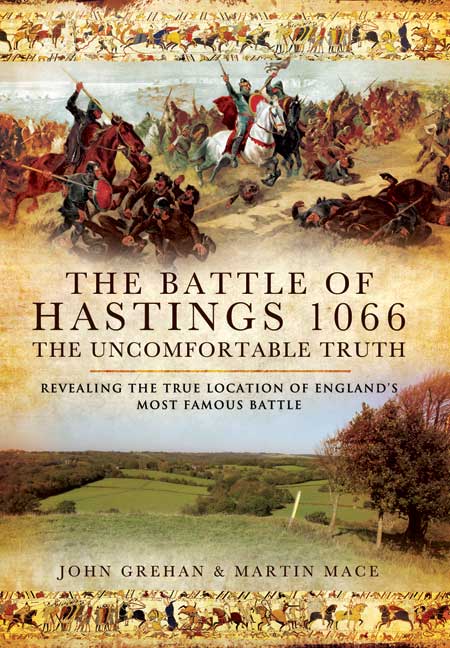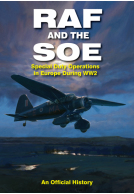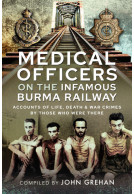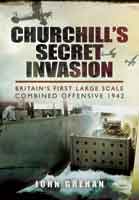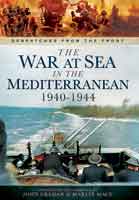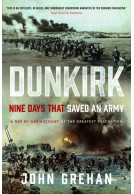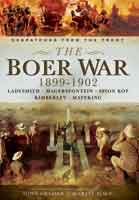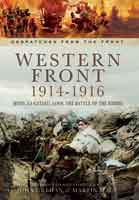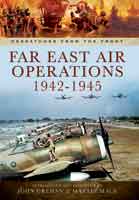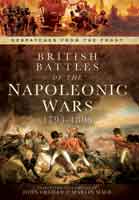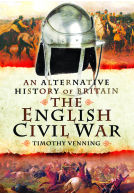The Battle of Hastings 1066 - The Uncomfortable Truth (ePub)
Revealing the true location of England's most famous battle
Imprint: Pen & Sword Military
File Size: 10.2 MB (.epub)
Pages: 182
Illustrations: 30 B&W images
ISBN: 9781781599846
Published: 29th October 2012
The Battle of Hastings is the most defining event in English history. As such, its every detail has been analysed by scholars and interpreted by historians. Yet one of the most fundamental aspect of the battle the place upon which it was fought has never been seriously questioned, until now. Could it really be the case that for almost 1,000 years everyone has been studying the wrong location?
In this in-depth study, the authors examine the early sources and the modern interpretations to unravel the compulsive evidence that historians have chosen to ignore because it does not fit the traditional view of where the battle was fought.
Most importantly, the authors investigate the terrain of the battlefield and the archaeological data to reveal exactly where history was made.
This book was an eye-opening read! I had no idea that the Battle of Hastings could have been fought in a different location than what is commonly believed. John Grehan and Martin Mace have done an excellent job of researching and presenting the evidence for their theory. The authors provide a detailed account of the events leading up to the battle, as well as the battle itself. They also provide a thorough analysis of the archaeological evidence. This is one for history fans to peruse and debate.
NetGalley, June Lee
"The account is one of the best I have read; it is a superb overview of that dramatic year, in which England had four kings. It explains the complicated process of the politics of the time and how William believed he was the rightful King of England with Harold the usurper."
Dr Adrian Greaves, The Anglo-Zulu War Historical Society
I really enjoyed this book not only did it tell the story of the battle of Hastings but also the controversy over which hill it was actually on and if the tapestry of William the conqueror was actually of the battle of Hastings or a later battle. The author uses a number of different points of views in the search for the truth. This book has great flow and excellent if you just love learning new things about history.
NetGalley, claire lavin
This was a great read! I loved the in-depth analysis and the rundown of the issues that surround the battle of Hastings. While we have contemporary sources, what we are gleaning from modern study is very profound, and worth a deeper look at the official battle site - and the possible new location.
NetGalley, Rebecca Hill
Absolutely amazing read, and one that was well worth the time to sit and read through. I was blown away through the information and the commentary by the author.
Perfect for those who are interested in the Battle of Hastings and the Norman invasion!
Rating: 5 out of 5 stars
NetGalley, Wendy M Rhodes
Brilliant written, well researched, well argued. A fascinating book. Definitely recommended.
The long-accepted, traditional view of historians was that the battle was fought on Battle Hill, in the grounds of what is now Battle Abbey. Over many years, this was a “fact” that was not challenged, as indeed was the idea that the abbey was built on the spot where King Harold died.
NetGalley, Angela Thomas
Following on from the theories proposed by British military historian, Jim Bradbury, the authors of this book decided to explore in depth the idea of a different site for the battle. They researched, using primary sources and the work of historians from different eras. They looked at the geographical features mentioned by the oldest sources of information and compared them with the topography of the locations. Factoring in the knowledge they gleaned about how the battle was fought and archaeological evidence – or lack of – they came to a conclusion that was at odds with the traditional view.
I enjoyed this book immensely. The arguments for and against various proposals were clear and backed up by many sources. Grehan and Mace have produced a well written and authoritative book on this important battle in the history of Britain.
Rating: 5 out of 5 stars
NetGalley, Paula Cwikla
Mr Grehan and Mr Mace have released a fantastically researched and well written book on one of the most influential battles known to man. Even though the battle was so important to life as we know it today, not many know about it or why it was so important. While the authors shed some new light as well I greatly appreciate a well researched title being released so more people can learn about this event.
Don't let the subject matter scare you off, it is incredibly accessible for people with any level of history nerd in their blood, even those without some. It does not read like a text book and will keep you interested from page one.
Rating: 5 out of 5 stars
NetGalley, Caroline Craig David
I am the biggest history nerd to have every existed and this book just hit different. The idea that the location has never been known is something that never really clicked in my mind. I appreciated the thorough research and layout of this book. Excellent.
As featured in.
The Independent 22/3/17
The authors make a good historical argument, demonstrating that there is little early evidence to support the traditional battlefield. Clearly more archaeology is needed in the area, and hopefully the true site will eventually be found. In the meantime this is a good examination of the evidence against the current site (or the lack of evidence in its favour).
History of War website
The book bowls along and is a real page turner.
History Today
The authors look in depth at the source material, and do this with a very critical eye. In conclusion, this is an in-depth study and, indeed, the authors have consulted many sources... As an academically-flavoured work, it is quite well written and remains remarkably accessible. The book remains excellent from an academic point of view...This book is a little gem for experienced readers.
Medieval Warfare
I have just finished reading John Grehan and Martin Mace’s The Battle of Hastings 1066. I was absolutely pleased to find that the views expressed in my book on Hastings published in 1998 had finally brought some reaction. The idea that the battle may have been fought on Caldbec Hill and not on the traditional Battle Hill site seemed to me quite a reasonable suggestion and one that had not clearly been put forward previously. I always realised that present use of the Abbey site for visitors, and its importance for the modern Battle, would act against locals being over-keen to accept the idea but was surprised that no one else, until now, had taken up the suggestion of an alternative site seriously.
Jim Bradbury
This new book is a careful investigation into the question of the location of the battle. In my book it was only part of the content since I was looking at the developments that led up to the battle as well as its history and consequences in general. This book looks at the site question in far more detail. It has an interesting review of previous historian’s comments. It looks carefully at the geography of the area. It examines the battle with detailed comment on how various manoeuvres and developments in the conflict could have occurred on possible sites. It seems to me to come to sensible conclusions. Sufficient evidence for such a distant event is always difficult to find in order to reach precise conclusions. In fact very few medieval battles can be exactly placed – and we know the recent change of view over the site of another of the best known medieval battles – Bosworth. I agree with the authors that, the evidence is not absolutely decisive but that the best present conclusion is that Caldbec Hill is more likely to be the battle site. Their discussion also looks at other placed mentioned in the evidence, such as Senlac and Malfosse, and again I largely agree with their conclusions here. I did notice the appearance of the word ‘Santlache’ (p.129 from Lemmon) which strikes me as the best bet of another mention of Senlac and might have been worth pursuing further. The very name Malfosse certainly would support the idea of it being a possible site for major burial. I liked the argument that the Abbey site might have been chosen as a defensive position against future troop movements inland and that William might have raised his standard there as a reason for using the site for building.
Finally I find this an excellent book with good detail, careful examination of all sides of the question of the site, and well-argued conclusions. I just hope others will take notice this time. If only some archaeological work could settle the matter!
I have just finished reading John Grehan and Martin Mace’s The Battle of Hastings 1066. I was absolutely pleased to find that the views expressed in my book on Hastings published in 1998 had finally brought some reaction.
Jim Bradbury
The idea that the battle may have been fought on Caldbec Hill and not on the traditional Battle Hill site seemed to me quite a reasonable suggestion and one that had not clearly been put forward previously. I always realised that present use of the Abbey site for visitors, and its importance for the modern Battle, would act against locals being over-keen to accept the idea, but was surprised that no one else, until now, had taken up the suggestion of an alternative site seriously.
This new book is a careful investigation into the question of the location of the battle. In my book it was only part of the content since I was looking at the developments that led up to the battle as well as its history and consequences in general. This book looks at the site question in far more detail. It has an interesting review of previous historian’s comments. It looks carefully at the geography of the area. It examines the battle with detailed comment on how various manoeuvres and developments in the conflict could have occurred on possible sites. It seems to me to come to sensible conclusions.
Sufficient evidence for such a distant event is always difficult to find in order to reach precise conclusions. In fact very few medieval battles can be exactly placed – and we know the recent change of view over the site of another of the best known medieval battles – Bosworth.
I agree with the authors that the evidence is not absolutely decisive but that the best present conclusion is that Caldbec Hill is more likely to be the battle site. Their discussion also looks at other places mentioned in the evidence, such as Senlac and Malfosse, and again I largely agree with their conclusions here. I did notice the appearance of the word ‘Santlache’ (p.129 from Lemmon) which strikes me as the best bet of another mention of Senlac and might have been worth pursuing further. The very name Malfosse certainly would support the idea of it being a possible site for major burial.
I liked the argument that the Abbey site might have been chosen as a defensive position against future troop movements inland and that William might have raised his standard there as a reason for using the site for building. The Mount Joy point is also interesting. I note that the name of Burne has been incorrectly printed twice as Bourne (p.127 and note 169). (Other minor printing errors noted: p.130 chose should be choose; p.142 Theses should be These).
Finally I find this an excellent book with good detail, careful examination of all sides of the question of the site, and well-argued conclusions. I just hope others will take notice this time. If only some archaeological work could settle the matter!
"Not only does it pose the challenging question where the Battle of Hastings was fought, it is also a gripping account of the run-up to and the battle itself and I did find it an enjoyable read. I love also the guide through the almost impenetrable who's' who of the claimants of the throne at that time."
Howard Leader BBC Lincolnshire & BBC Humberside
The Battle of Hastings 1066: The Uncomfortable Truth, claims the bloody clash between the Normans and the Saxons never took place on the battlefield at all, but just down the road on Caldbec Hill in Battle. John Grehan and Martin Mace spent two years researching and writing the book. The Battle of Hastings 1066: The Uncomfortable Truth, is published by Pen and Sword Books.
Hastings and St Leonard's Observer
About John Grehan
JOHN GREHAN has written, edited or contributed to more than 300 books and magazine articles covering a wide span of military history from the Iron Age to the recent conflict in Afghanistan. John has also appeared on local and national radio and television to advise on military history topics. He was employed as the Assistant Editor of Britain at War Magazine from its inception until 2014. John now devotes his time to writing and editing books.
About Martin Mace
Martin Mace has been involved in writing and publishing military history for more than twenty years. He began his career with local history, writing a book on the Second World War anti-invasion defences in West Sussex. Following the success of this book, he established Historic Military Press, which has published a wide range of titles. Having launched Britain at War Magazine, he has been its editor since the first issue in May 2007.







